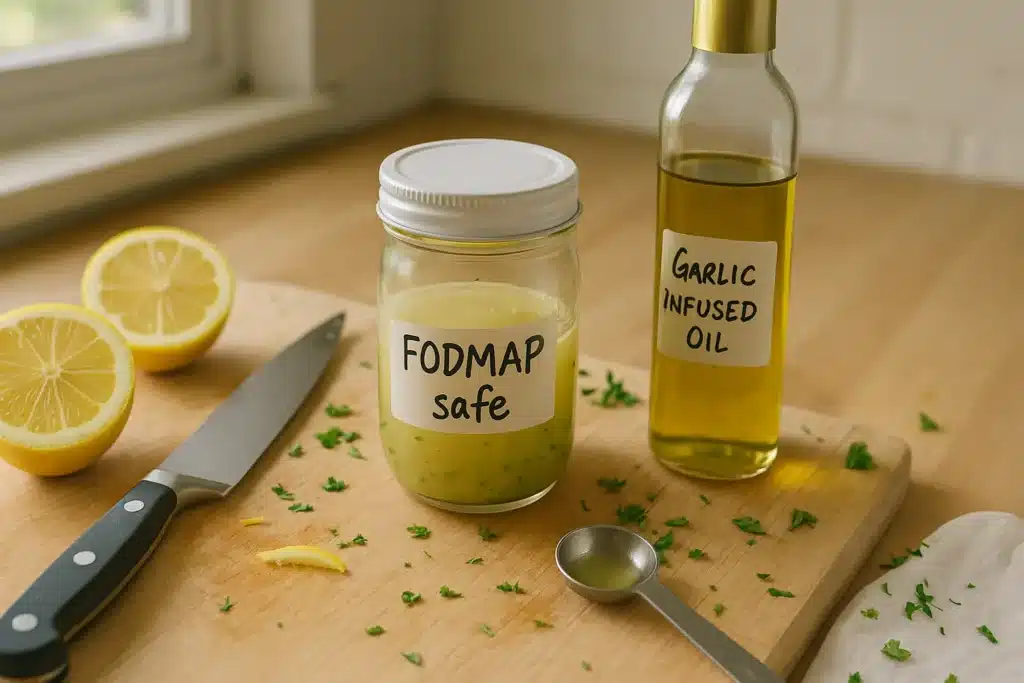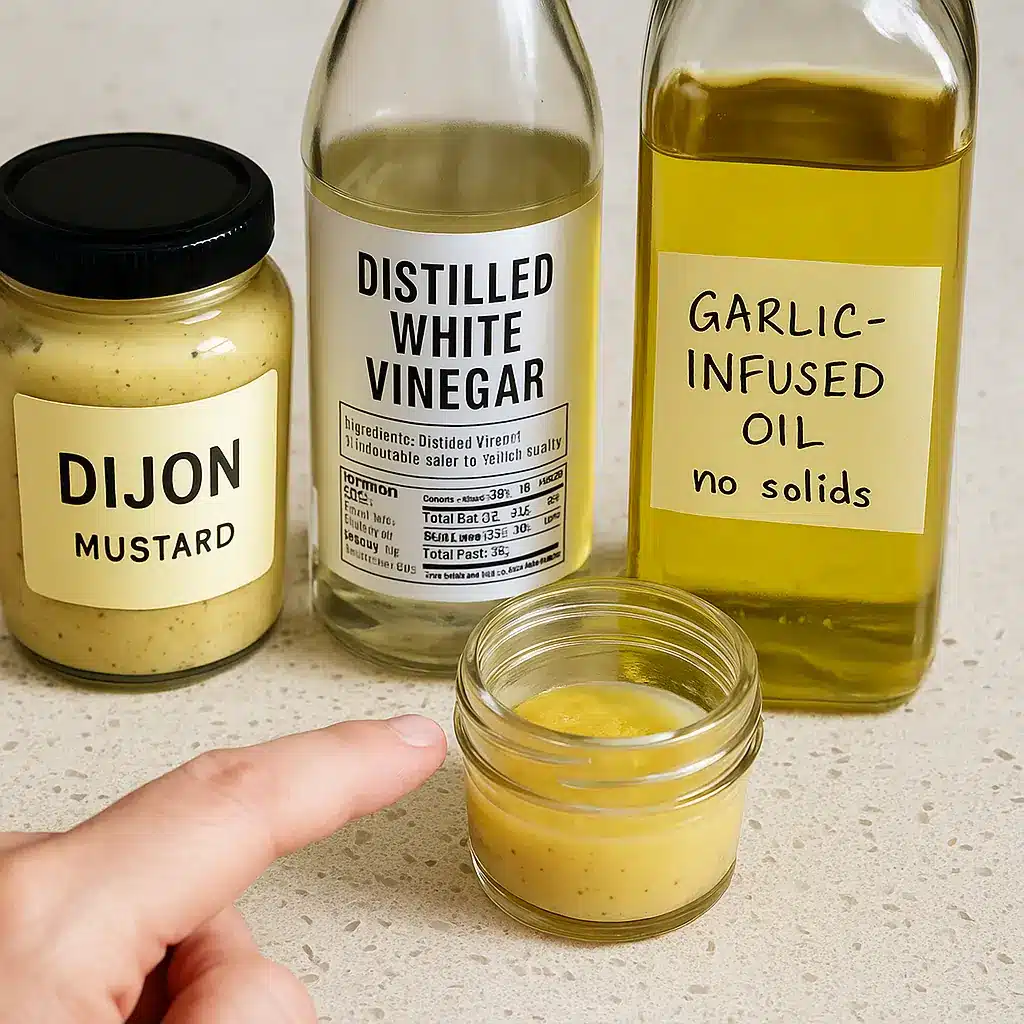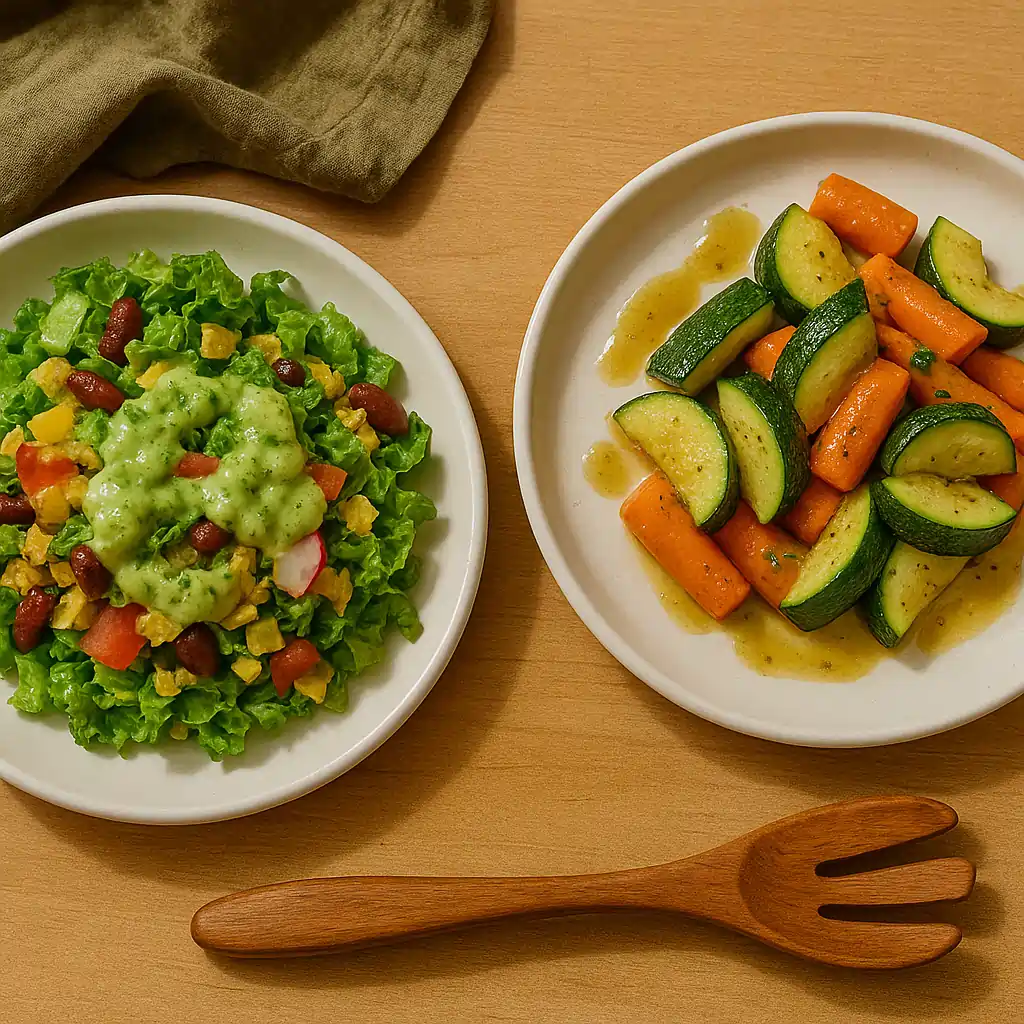“Flavor without fallout.” That became my motto the day I learned onion and garlic were wrecking my salads, not my cooking skills. I thought the fix was to eat bland, but nope—this low FODMAP salad dressing keeps the zip and skips the triggers. It’s bright, herby, and friendly on a jumpy gut, and it still tastes like real dinner.
My first attempt was chaos—just lemon and oil, and it drank like furniture polish. Then I tried garlic-infused oil, chives, and a smarter ratio, and bam, restaurant vibes without the aftermath. If you’ve been missing that garlicky magic, this is how we cheat the system (safely) and get it back.

Table of Contents
Table of Contents
FODMAP basics (brief, non-medical)
Low FODMAP is about limiting certain carbs that can ferment and cause symptoms. Onion and garlic are loaded with fructans, so they’re common culprits even in tiny amounts. The trick isn’t zero flavor—it’s choosing ingredients that deliver aroma without those carbs.
A couple mindset tips saved me. Portion size matters; your salad dressing serving is usually one to two tablespoons, so small tweaks go a long way. Labels matter too; mustard, mayo, and spice blends can hide onion or garlic powders, so I scan ingredients like a hawk and pick the clean stuff.
I’m not your doctor, and this isn’t medical advice, just a cook who learned the hard way. Start simple, test one change at a time, and notice how you feel. When things behave, keep notes on brands and amounts so you can repeat the win.
Low FODMAP Salad Dressing
Equipment
- small jar with lid
- measuring spoons
- microplane (for zest, optional)
- fine strainer (if making infused oil)
- small whisk (optional)
Ingredients
- 3 tbsp fresh lemon juice
- 1 tbsp rice vinegar
- 1 tsp Dijon mustard (low-FODMAP brand)
- 1 tbsp finely chopped chives
- 1 pinch ground cumin
- 1 pinch black pepper
- 6 tbsp garlic-infused olive oil (no solids)
- 2 tbsp cold water
Instructions
- In a small jar, combine lemon juice, rice vinegar, Dijon mustard, chopped chives, cumin, and pepper. Let sit for 2–3 minutes to bloom flavors.
- Add garlic-infused oil and water. Seal the jar and shake vigorously for 20 seconds until emulsified and glossy.
- Taste on greens. Adjust with water if too sharp, more lemon if too flat, or extra chives for brightness. Optional: lemon zest or nutritional yeast for umami.
- Store in the fridge for 1–2 weeks. Shake before use. Label jar with date and ingredients for easy tracking.
Notes
- Use a certified garlic-infused oil with no solids. Optional swaps: ACV for rice vinegar, lime juice instead of lemon, or avocado oil for milder taste.
- Add chives, lemon zest, cumin, or nutritional yeast for variety.
- Keep it chilled and shake before using.
Safe aromatics (infused oils, chives, citrus, spices)
Garlic-infused oil is the secret handshake. The flavor molecules are fat-soluble, but the troublesome fructans are water-soluble, so properly infused oil gives aroma without the FODMAPs. I buy a reputable bottle or make tiny batches, always straining out every last solid and keeping it chilled.
Chives and the green tops of scallions are my fresh, oniony backup singers. They taste bright and clean, and no one at the table misses the bulb. Citrus zest is free perfume; I grate lemon or lime right over the bowl so the oils don’t escape, and suddenly the dressing smells like sunshine.
Spice rack to the rescue. Cumin brings warmth, coriander adds a citrusy whisper, smoked paprika delivers mood, and black pepper wakes everything up. Dijon mustard helps emulsify and is typically fine in small amounts, but I still grab a brand with a short, simple ingredient list.
If you want umami, nutritional yeast is clutch and reads a bit cheesy. Miso can be tricky because some brands add garlic or onion; if you use it, go tiny and check the label. I’ve also leaned on a pinch of dried oregano or dill for lift when the crisper is sad, and it totally works.
Base recipe (bright, clingy, IBS-friendly)

Here’s my everyday low FODMAP vinaigrette that actually clings to greens. In a small jar I add three tablespoons fresh lemon juice, one tablespoon rice vinegar, one teaspoon Dijon, one tablespoon very finely chopped chives, a pinch of ground cumin, and a grind of black pepper. I let it sit two to three minutes so the acid softens the chives and wakes the spices.
I pour in six tablespoons garlic-infused olive oil plus two tablespoons cold water and shake hard for twenty seconds. The water lightens calories and tightens texture, so it coats romaine instead of puddling. I taste on a lettuce leaf, not a spoon, because greens tell the truth.
If it’s too sharp, I add another tablespoon water or a tiny squeeze more lemon depending on mood. If it reads flat, I add a whisper of zest or another pinch of chives and it pops. Salt is optional and light; most days the acid and herbs do the heavy lifting and I don’t miss it.
For variety, swap rice vinegar for apple cider vinegar and a touch of lime, still keeping the same ratio. If your olive oil is peppery, blend it half-and-half with avocado oil to keep bitterness down. The bones of the recipe don’t change: acid, emulsifier, aromatics, infused oil, a splash of water, shake, then taste and tweak.
Creamy option (lactose-free or dairy-free)
When I’m craving creamy, I go two ways and keep it low FODMAP. The dairy route is lactose-free Greek yogurt: I whisk a third cup with two tablespoons lemon juice, one tablespoon rice vinegar, one teaspoon Dijon, two tablespoons garlic-infused oil, two tablespoons water, chopped chives, and pepper. It turns silky and clings like ranch, but it’s bright, not heavy.
For dairy-free, tahini plays the hero. I stir three tablespoons tahini with three tablespoons warm water till smooth, then add two tablespoons lemon juice, one tablespoon rice vinegar, one teaspoon Dijon, two tablespoons garlic-infused oil, chives, and pepper. It’s nutty, citrusy, and perfect on chopped salads or grain-free bowls.
Avocado works too if portions stay friendly. I blend one quarter of a medium avocado with two tablespoons lemon juice, two tablespoons water, two tablespoons garlic-infused oil, a half teaspoon Dijon, chives, and pepper until it pours like light cream. If it thickens in the fridge, I loosen with a spoon of water and it’s back to business.
If any creamy version tastes shy, a squeeze more lemon or a pinch of dill lifts it. If it leans bitter, cut it with a little extra water before you reach for more oil. Tiny fixes, huge wins, and your salad suddenly feels like a main course again.
Ingredient checklist (what to use, what to skip)
Think clean and simple, with brand labels you trust. You want garlic-infused oil with zero solids left in the bottle, fresh lemon or lime juice, low-FODMAP vinegars like rice or apple cider, and a Dijon that doesn’t hide onion or garlic powder. Chives, scallion tops, parsley, and dill bring safe, bright aromatics, while cumin, coriander, smoked paprika, and black pepper build depth.
For emulsifiers and body, Dijon is the steady choice and tahini is the plant-based backup. Nutritional yeast adds umami without drama. If you need sweetness, go minimal and test—pure maple syrup can be low FODMAP in small portions, but I usually skip sweetener and manage tartness with water and zest instead.
What to avoid is short and strict. No onion powder, no garlic powder, and no chunky alliums hiding in jars. Be cautious with “spice blends,” “natural flavors,” and restaurant dressings that rarely disclose the good stuff; they often sneak in the very things that set you back.
When in doubt, make it yourself and write the brand and amounts on a sticky note. I keep those notes on the fridge like a tiny lab log, because repeating a calm stomach is the whole game. If you also care about sodium or sugars, the ideas in Low Sodium Salad Dressing (No-Salt Added, Big Flavor) and Sugar-Free Salad Dressing (No Added Sweeteners) plug straight into this template.
Storage
Vinaigrettes like these keep about one to two weeks in the fridge. I label the lid with the date and the vibe—“Lemon + Chive, LF”—so future-me knows what’s inside. If it separates, I just shake hard; if olive oil firms up when cold, I let the jar sit on the counter for ten minutes or run it under lukewarm water.
Creamy versions are fresher and shorter-lived, usually three to five days. Yogurt-based dressings can tighten in the fridge; a spoon of water and a quick whisk brings them back. Avocado or tahini versions may darken slightly; press plastic wrap to the surface before capping to slow it down.
A special note on infused oils. I prefer purchasing a commercial garlic-infused oil from a trusted brand. If you make your own, keep the batch small, strain out every solid, store it refrigerated, and use within a few days. When anything smells off, looks cloudy in a weird way, or wears a fuzzy hat, it’s out—no heroic rescues.
Serving ideas & quick riffs

This low fodmap vinaigrette loves romaine, butter lettuce, cucumbers, and radishes. On taco-ish salads I add cumin and lime and it just sings, and on roasted carrots or zucchini it cuts richness like a pro.
For a bigger skill map, the hub at My Guide to Salad Dressing shows the master ratios so you can riff without fear. Honest talk—once you learn to season with acid and herbs, you won’t miss the onion bomb.
Conclusion
You don’t have to choose between flavor and feeling okay. With garlic-infused oil, bright citrus, and herb power, a low FODMAP salad dressing can be zippy, creamy, or anything in between—and your gut stays calmer. Start with the base, tweak with water and zest instead of sugar, and keep labels clean, and you’ll have a dependable house dressing on repeat.
